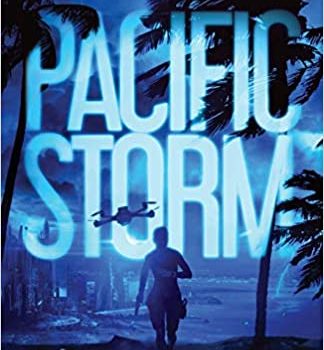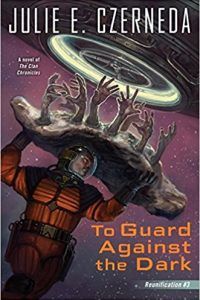Russell Letson Reviews Pacific Storm by Linda Nagata
 Pacific Storm, Linda Nagata (Mythic Island Press, 978-1937197339, $14.00, 264 pp, tp) October 2020.
Pacific Storm, Linda Nagata (Mythic Island Press, 978-1937197339, $14.00, 264 pp, tp) October 2020.
Linda Nagata made her reputation with far-far-future adventures featuring near-magical nanotechnology and post-human characters, but in the last few years she has also developed a strong line of closer-to-home scenarios. This day-after-tomorrow work has veered toward military SF in her Red Trilogy (2013-15) and toward the technothriller in The Last Good Man (2017), both of which portray protagonists working in high-tech, wired-up – but still murky – worlds of international conflict. Now, in Pacific Storm, she explores an increasingly relevant near-future-nightmare territory, one that sits comfortably (or uncomfortably) next to recent work by Christopher Brown (Rule of Capture, Failed State), Greg Egan (Perihelion Summer), Nancy Kress (Sea Change), and even the political-satirical side of Charles Stross (Dead Lies Dreaming).
Climate change, international business/politics, and an alphabet-soup artificial-intelligence/virtual-reality computational-communications infrastructure all contribute to the environment in which Ava Arnette operates. Ava – ex-army, ex-Honolulu police department – works as a security officer for the Kahanamoku Coastal Authority (KCA), monitoring a Waikiki tourist zone rebuilt and reinforced after the massively destructive Hurricane Nolo scoured `Oahu nine years earlier. The interests served by the KCA are effectively those of the Chinese, who bankrolled the rebuilding and who are on the brink of signing a deal that will give China a 99-year, Hong-Kong-style lease on Hawai`i, which is being abandoned by a “feckless and financially strapped” American government.
The book opens with a familiar narrative-hook sequence that introduces the book’s cast and setting and the (literal) machineries of policing: Ava and a colleague pursue an EP (Expected Perpetrator) on the prowl, a sexual predator flagged and tracked by HADAFA, the law-enforcement world’s AI-driven surveillance and profiling system. At the same time, another Category 5 superstorm is bearing down on the island, and everyone is either evacuating or preparing to hunker down. The unexpected outcome of the chase makes Ava suspect that someone has hacked into HADAFA, and following up on that suspicion eventually leads to a much more extensive and threatening plot, in both the narrative and conspiratorial senses.
The implications of the strange case of the Expected Perpetrator take Ava down several rabbit holes, starting with the puzzle of the hacked surveillance system, on to a possible terrorist plot, and eventually to matters of motives, including those of people whose loyalties she would not have otherwise questioned. The investigation also takes us on a tour of a transformed Honolulu, from the reconstituted beachfront theme-park; to the partly-recovered ruined cityscape dotted with rebuilt, storm-resistant neighborhoods of concrete dome-homes; to abandoned, toxic “ghost blocks” and rewilded military zones.
The self-driving vehicles, the panopticon of universally-connected smart VR glasses and tablets and phones, the AI-driven data and social-credit networks – these are enabling devices, the technological environment in which Ava and her colleagues work, and that work is fairly familiar: ensuring the safety of the tourists whose money drives the economy. The most exotic inventions in the non-cop world are semi-robotic artificial life-forms and an engineered (or perhaps weaponized) fungal “angel dust” originally intended as a means of cleaning up the decaying bodies left behind by Hurricane Nolo. For all that science-fictional furniture and scenario-setting, though, the heart of the story depends on questions of trust and of knowing – who to believe, how far to trust, and what questions and issues and interests to be wary of. When Ava stumbles onto a secret security operation, she is dropped into a world of secrets, hidden agendas, possible betrayals, and confused loyalties. She needs to rely on her co-workers and old police-force colleagues, but there are under- and cross-currents everywhere: hostility to the Chinese takeover, variously intense Hawaiian-sovereignty sentiments, the push-pull of children living on the mainland, and the appeal of a new lover with his own career imperatives. It’s not just data systems that can be hacked and spoofed or are simply flawed.
But what did Ava know of truth?
…[S]he’d come to rely on HADAFA, trusting the system to show her the shape of people’s hearts, even though the conclusions she’d been allowed to see were half-truths based on incomplete data sets, crucial information absent if it intersected in some way with an area of national security.
As the clock ticks down toward natural and man-made disasters and the puzzle pieces shift into new shapes, Ava’s options narrow to a series of increasingly desperate confrontations and chases worthy of any of the “action heroes in century-old movies” that she thinks of on the novel’s first page. Indeed, she is embedded in a propulsive intrigue-thriller-disaster format, detailed and textured and specific enough that its progress can be mapped onto contemporary Honolulu, a real garden with imaginary monsters in it.
Russell Letson, Contributing Editor, is a not-quite-retired freelance writer living in St. Cloud MN. He has been loitering around the SF world since childhood and been writing about it since his long-ago grad school days. In between, he published a good bit of business-technology and music journalism. He is still working on a book about Hawaiian slack key guitar.
This review and more like it in the December 2020 issue of Locus.
 While you are here, please take a moment to support Locus with a one-time or recurring donation. We rely on reader donations to keep the magazine and site going, and would like to keep the site paywall free, but WE NEED YOUR FINANCIAL SUPPORT to continue quality coverage of the science fiction and fantasy field.
While you are here, please take a moment to support Locus with a one-time or recurring donation. We rely on reader donations to keep the magazine and site going, and would like to keep the site paywall free, but WE NEED YOUR FINANCIAL SUPPORT to continue quality coverage of the science fiction and fantasy field.
©Locus Magazine. Copyrighted material may not be republished without permission of LSFF.








